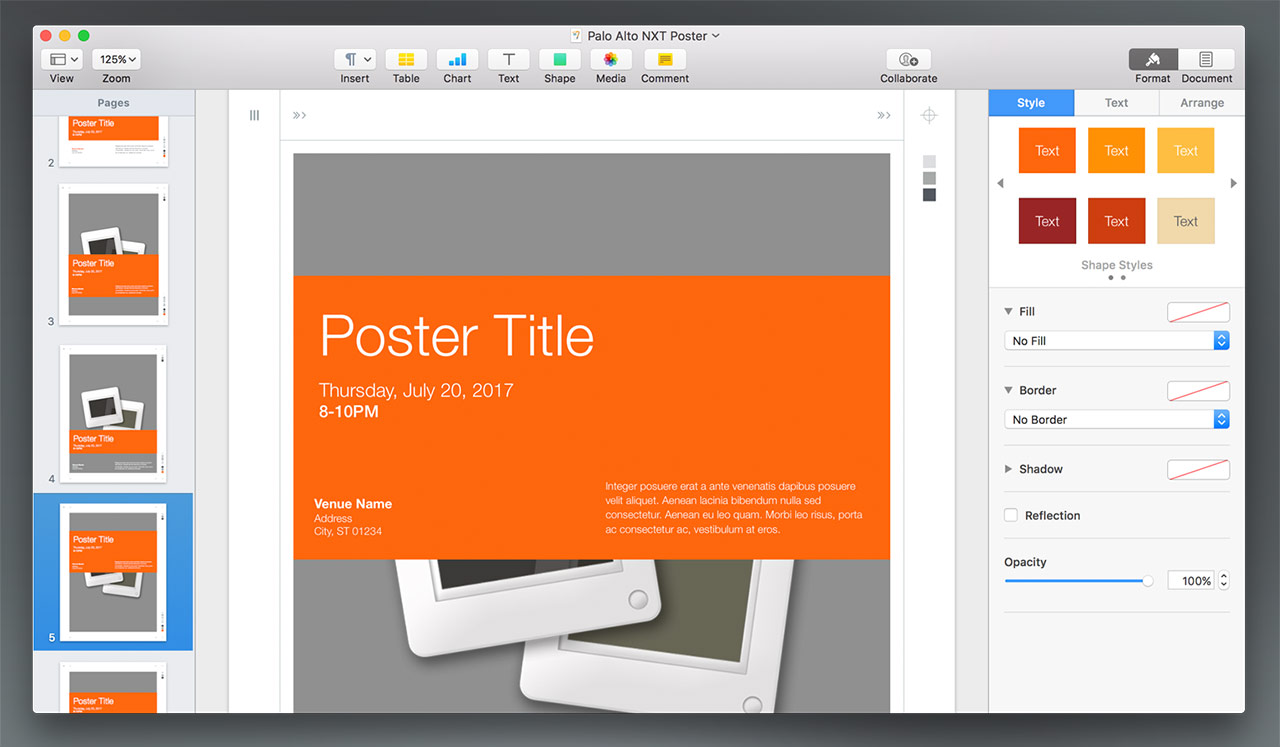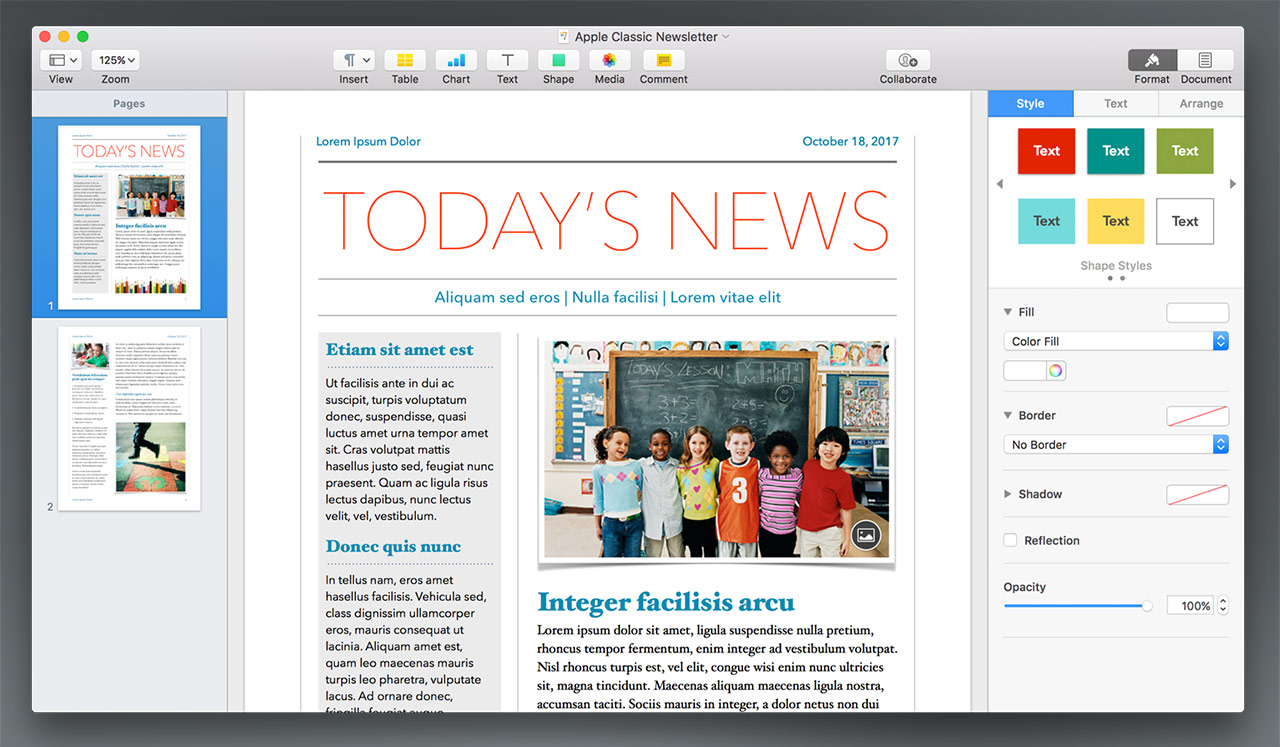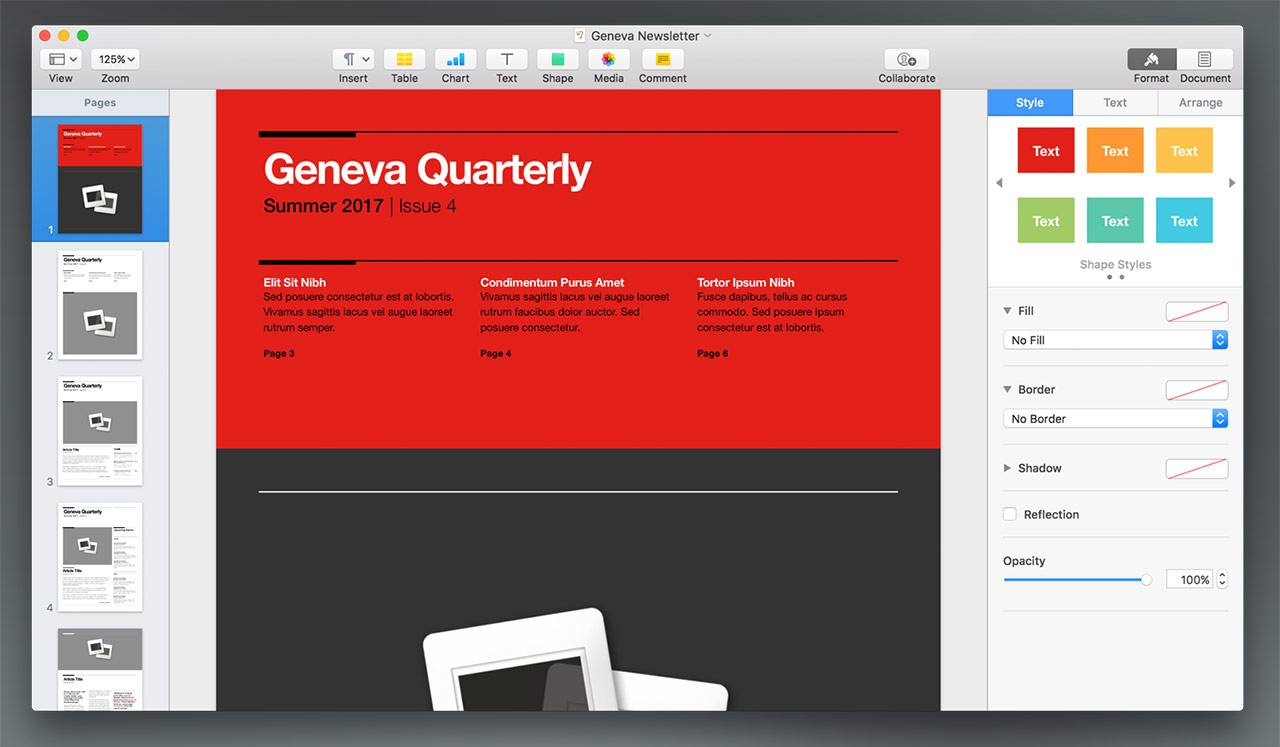Updating to Pages 6.x?
Pages 6.x is here - learn everything you'll need to know to make the most of
the transition forward to the new generation.
Pages 6.x Upgrade Report
Updated 10/18/2017
Update 3/30/2018: Keynote 8 and Pages 7 are now available. Our updated Upgrade Report is now available, and some of the information below may now be out-of-date at this time.
Overview
The latest generation of Pages is here: Pages 6.2 arrived on June 14th, a comprehensive update to the earlier 6.x builds launched alongside MacOS Sierra in September and October '16, further refining the latest generation of Apple's publishing app and bringing some long-awaited updates to the architectural transition that began with the launch of Pages 5.0. Pages for iOS is updated as well to version 3.2, adopting many of the same core features of the 6.2 update for the desktop and continuing to add increasing feature-parity with the desktop app.
While the shakeup that came with Pages 5's launch left a number of lingering questions in the air regarding the scope of Apple's road-map for the future of its publishing app, the 6.2 Update closes some of the functional gaps left open during the early stages of the transition, making it much easier than before to transition from an '09-centric workflow toward the updated, cloud-centric workflow of Pages 6.x.
Compatibility: The Ins & Outs
The architectural changes ushered in with the launch of Pages 5 introduced fundamental compatibility issues with templates built for the '09 document architecture, rendering all templates built for the classic architecture inoperable in Pages 5.x+. While Pages 5.x/6.x have since added additional backward-compatibility for documents created with earlier versions of Pages, Template files for prior versions are still inoperable in Pages 6.x - you'll need to continue using Pages '09 to use our Classic, Master Layout-based Templates.
Our latest NXT-Gen Template systems - Palo Alto NXT for Pages and Geneva for Pages as of this writing - are built specifically for the updated Pages 5.x/6.x architecture, and conversely aren't directly compatible with older editions of Pages. We're in the process of updating our Classic '09 Template sets like OM, Sonoma and Tokyo to full NXT status at this time: stay tuned for updates on that front.
Our new NXT-Gen Templates for Pages are employing something of a meta-architecture, blending the best of the new Flat Architecture in Pages 5.x/6.x with the broader diversity the Classic '09 template architecture allowed for. While the new templates don't offer the same level of granular options available in the Classic templates, our NXT templates include a significantly broader base of page styles/archetypes than are included with any of the built-in, Apple-Designed templates, for instance - creating what we think is a better balance between old and new formats.

An Evolving Workflow
If you're used to the Classic '09 Template workflow, updating to Pages 5.x/6/x can be quite a change from what you're used to, with its own unique set of pros and cons.
The new Flat Architecture is thoroughly cloud/mobile-centric, removing considerable resources behind-the-scenes of each template file to create a lighter, more-portable base format. Gone, for instance, are all of the Master Layouts you would traditionally insert via the Insert Page/Section buttons in '09: a template is now a What You See is What You Get construct, including only the pages present when you generate a new document. Pages 5.x/6.x has become very similar to Word in that respect, with built-in templates now including only a page or two worth of starter layouts in the default templates. (By contrast, Apple's Newsletter Templates in Pages '09 contained a minimum of 9 Page Masters you could insert in any arrangement you like.)

Our hybrid NXT architecture for Pages includes many more page archetypes by default with a template, but the templates themselves are built around this updated Flat Architecture to ensure broad compatibility with the entire Pages 5.x/6.x ecosystem of desktop/mobile/cloud. They are still bound by the central premise of the Flat Architecture, though - What You See is What You Get - so the process of using one of the newer templates is itself different than you're used to if you're updating from '08/'09.
The Geneva for Pages Newsletter, for example, contains 15 pages when you create a new document. What You See is What You Get, so those 15 pages include multiple styles of Cover designs, for instance, before you get into internal page styles. Duplicate / Delete is the order of the day in a Flat template, then: delete the cover styles you don't want to use, and duplicate any of the internal pages you'll want to use multiple times. It takes some getting used to if you're coming from the '09 approach of building up the document from Masters as you're writing.

Likewise, the ability to Copy/Paste individual Pages has yet to return to Pages 5.x/6.x - so building a complex, mixed-document build is a bit more complex than it was in the old architecture. You can't, for instance, select one of the Small Poster pages and substitute it in as a cover on the Vertical Brochure - not by Copy/Paste of the page itself, at least. You can, however, copy & paste the Contents of the page to achieve the same ends, provided you're doing so between like-styled documents using the same page orientation, etc. We have a more in-depth look at mixed-mode document editing and techniques for blending Page Layout and Word Processing-mode document available in our Mixed-Mode Documents Tutorial - we recommending following along in detail if this is the sort of editing you're most likely to do.
New Features & Notable Omissions
The shift to the new Flat Architecture left a lot of open questions during the Pages 5.x transition. The Pages 6.x branch has closed the loop a bit with a range of new cloud-centric features that deliver on the promise implied by the shift to the deconstructed, mobile-first architecture. Apple profiles a few of the more significant additions on their What's New in Pages for Mac page, and we recommend you start there if this is your first real look at what the 6.x Upgrade brings to the table.
Real-Time Collaboration - currently in Beta - allows you to share a document via iCloud with your team and work together on authoring and edits in real time no matter where they're located. This is a long-awaited and very welcome addition here, and while we've usually had good results in our testing since the launch of Pages 6.0, this service is still evolving and may be subject to occasional hiccups and growing pains - they (still) use the Beta tag for a reason. So always keep a backup of the file you're sharing out before you invite everyone in to work alongside you.
Bookmarks are back as of Pages 6.1 - enabling you to easily link from one section of your document to another. And perhaps more importantly, you can once again Link Text Boxes in your documents, bringing back one of the features that made Pages such a flexible publishing tool in '09.
Fixed-layout ePub Export is new with Pages 6.2 - and while not as robust as a dedicated ePub authoring tool a-la Apple's own iBooks Author, provides a one-click option for exporting your documents to ePub format without much hassle. And Document-wide Font Changes are now as easy in Pages 6.2 as we discussed in our Keynote 7.1 round-up earlier this year.
Some Classic features have still not returned, however, which might limit the overall utility of the app if they're part of your workflow. Mail Merge, for instance, is still missing in the new architecture. While some Automator-based workarounds have been making the rounds the last year, none of them are quite as simple to use as the native '09 process, making Pages a questionable choice for authoring if you're going to export multiple addressed copies of a document.
Overall, though, with the 6.1 and 6.2 updates Apple have largely closed the major gaps between Pages '09 and the new apps, with major differences now being extensions of the architecture itself vs. fundamental features.
Moving Forward
We'll be supporting Pages 5.x as our functional baseline for new Template System releases moving forward, holding the door open for authors who haven't yet made the leap to Sierra and Pages 6.x. As always, consult the Compatibility Matrix at the top of each theme page if you're ever in doubt as to which versions of Pages a template is designed for.
With the dust of the Pages 5 launch largely settled now and our new meta-architecture in-the-wild with Geneva and Palo Alto NXT, we're planning to turn our attention toward updating our currently-retired Classic '09 templates in our back catalog to full NXT status and finally closing the door on the classic Keynote/Pages '08/'09 architecture.
This page will be updated as more information is available. Last Updated 10.18.2017







